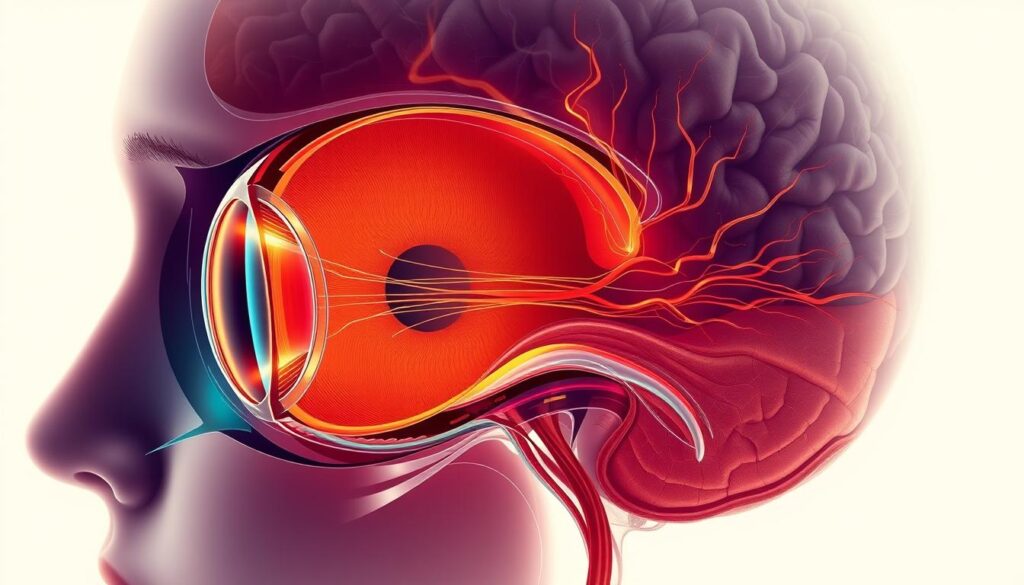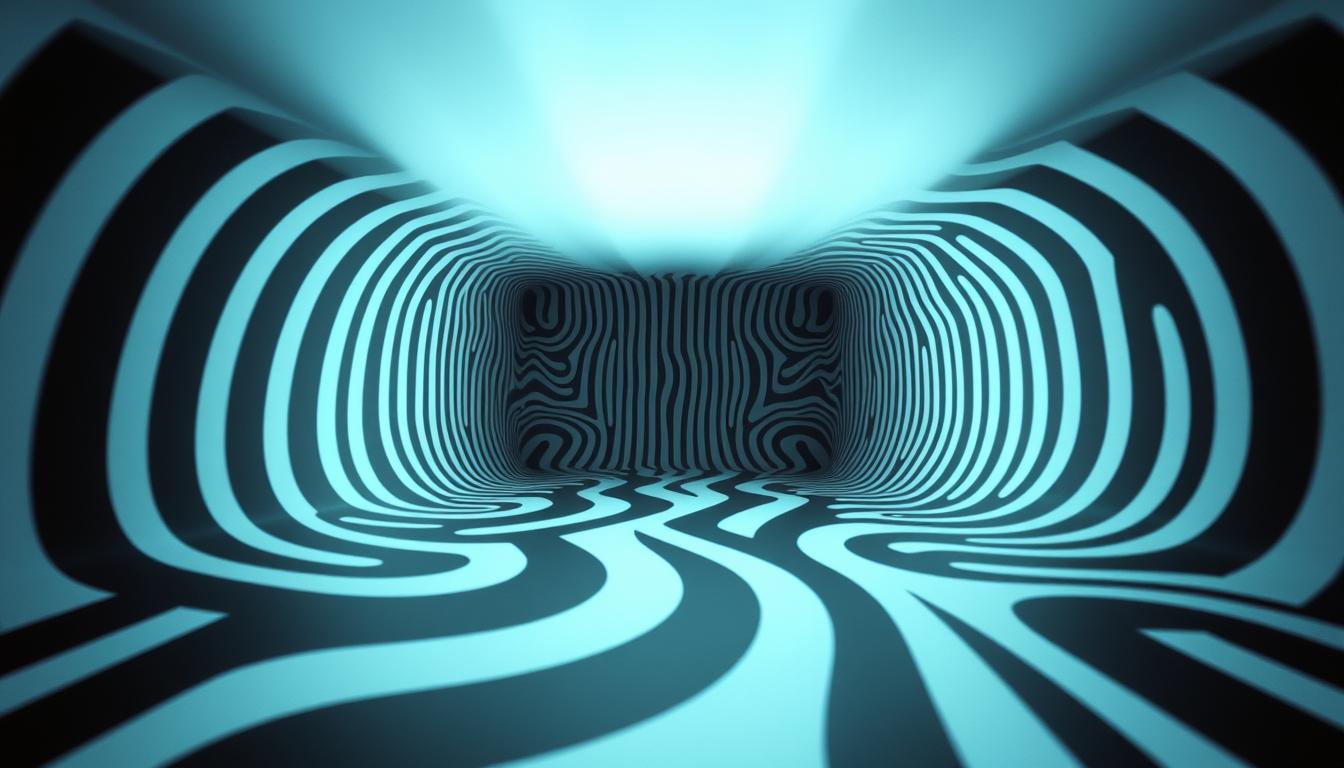Get ready to have your mind blown by an optical illusion that makes you question your vision. This illusion is a masterclass in visual perception. It plays tricks on your brain and challenges your understanding of reality.
The optical illusion is a powerful tool that reveals the complexities of human visual perception. It makes you wonder how our brain processes visual information and how it can be deceived.

The illusion that makes you question your vision is a fascinating phenomenon that has captivated people for centuries. By exploring the science behind optical illusions and visual perception, we can gain a deeper understanding. We learn how our brains process visual information and how we can be deceived by clever tricks and illusions.
Introduction to Optical Illusions
Optical illusions are a great way to learn about visual perception and how our brains process visual information. The study of optical illusions has led to a greater understanding of the complexities of human vision. It shows how our brains can be tricked in many ways.
Key Takeaways
- Optical illusions can trick our brains and challenge our understanding of reality
- Visual perception is a complex process that can be influenced by many factors
- The study of optical illusions can reveal the intricacies of human vision
- Optical illusions can be used to learn about the science of visual perception
- The illusion that makes you question your vision is a powerful tool for understanding visual perception
The Mind-Bending Power of Visual Perception
Our brain’s ability to process visual information is complex and fascinating. It influences how we see reality, often through brain processing and optical illusions. This makes us question the true nature of reality and perception.
When we look at an image, our brain quickly processes a lot of information. But, this process can be wrong, especially with optical illusions. These illusions can make us see things that aren’t there or misread what our eyes see.
- Context: The surroundings and environment greatly impact our view of an image.
- Past experiences: Our brains use past experiences to understand the world, sometimes wrongly.
- Expectations: What we expect to see can also influence our perception, leading to seeing things that aren’t there.
Understanding how our brains process visual information and how optical illusions trick us is enlightening. It shows us the complex and fascinating nature of reality and perception.
Understanding This Remarkable Illusion That Makes You Question Your Vision
This illusion is a visual trick that can really mess with your head. It plays with how we see things, making us question what’s real. Our brain fills in gaps and makes guesses about what we see.
Some key aspects of this illusion include:
- Depth perception: Our brain uses cues like shading, texture, and perspective to determine the distance of objects from us.
- Color perception: The way we perceive colors can be influenced by the surrounding environment and the context in which we see them.
- Contextual influence: The information we have about the scene or object can affect how we interpret the visual data.
By understanding these factors, we can better appreciate the complexity of the illusion that makes you question your vision. It is a remarkable example of a visual trick that can be mind-bending, highlighting the dynamic and sometimes unpredictable nature of human perception.
As we delve deeper into the science behind this illusion, we will explore how it works and what it reveals about our visual system. The study of such illusions can provide valuable insights into the workings of the human brain, helping us to better understand the intricate processes that underlie our perception of reality.
The Science Behind the Visual Trick
Understanding illusions is key to seeing their complexity. Our brain’s neural pathways play a big role in how we see things. Sometimes, this can lead to seeing things that aren’t really there.
Our brain uses what we’ve seen before and what we expect to see. This can make us see things differently than they really are. It’s a way our brain tries to make sense of the world.
Colors can look different based on where we are and the light around us. Our brain uses what’s around us to figure out what color something is. This means the same color can look different depending on its surroundings.
Neural Pathways and Visual Processing
Our brain’s neural pathways help us understand what we see. This process can be affected by many things, like what we’re paying attention to and how we feel. Illusions show us how our brain can be tricked into seeing things that aren’t there.
Color Perception and Light Interaction
Seeing colors is a complex process. It involves light, the object we’re looking at, and our brain. The science behind illusions shows that many things can affect how we see colors. This includes the environment around us and the light we’re in.
Cognitive Psychology Insights
Cognitive psychology helps us understand how our brain works with visual information. It shows how different factors can influence what we see. By learning about cognitive psychology, we can appreciate how complex our perception of the world is.
Historical Origins and Evolution
The history of illusions is long and fascinating. It shows how our brains can trick us into seeing things that aren’t there. From ancient times to now, people have always been interested in optical illusions.
For centuries, famous optical illusions have captured our attention. They help us understand how our brains process what we see. The history of illusions is rich, with contributions from many fields. By studying these illusions, we learn more about our perception of the world.
Here are some key points in the history of optical illusions:
- Ancient civilizations like the Greeks and Romans knew about optical illusions. They used them in their art and buildings.
- In the Renaissance, artists like Leonardo da Vinci and Michelangelo used illusions to create depth in their work.
- In the 19th and 20th centuries, scientists like Hermann von Helmholtz and Edwin Land greatly advanced our understanding of optical illusions.
Today, studying optical illusions is still a big deal. Scientists and artists work together to make new illusions. By knowing the history of illusions, we appreciate the complex world of human perception more.
How to Experience the Illusion Properly
To fully enjoy the illusion, knowing the best viewing conditions is key. A step-by-step guide will help you get the most out of it. It ensures you catch all the details that make it so amazing. By following these tips, you’ll see the illusion in all its wonder, avoiding common pitfalls.
For the best viewing conditions, create an environment that lets your brain process the visuals correctly. Adjust the lighting, distance, and angle to enhance the experience. Here are some tips to start:
- Adjust the lighting to a comfortable level, avoiding harsh or dim conditions
- Position yourself at a distance that allows you to take in the entire illusion
- Experiment with different angles to find the one that works best for you
By following this step-by-step guide and avoiding common mistakes, you’ll unlock the illusion’s full potential. It will be both fascinating and thought-provoking. Take your time, be patient, and don’t hesitate to try new things.
Real-World Applications and Uses
Optical illusions have many real-world applications in fields like art, design, and psychology. They are used to create unique designs and study how we see things. This helps us understand human perception and behavior.
Some interesting real-world applications of optical illusions include:
- Architecture: They make buildings look amazing by changing how we see space and size.
- Art: Artists use them to make pieces that challenge our view of reality.
- Design: They make designs more appealing and effective, influencing how we see and act.
In psychology, optical illusions help study how we perceive and behave. By looking at them, psychologists learn more about our brains and how they process visual information.

In summary, optical illusions have many uses in art, design, and psychology. They help us create unique designs, study perception, and understand the brain. This shows how fascinating and complex our brains are.
Similar Illusions That Challenge Perception
Optical illusions have long fascinated us. There are many similar illusions that test our perception. These range from simple shapes to complex designs. By studying these related visual phenomena, we learn how our brains see the world. This knowledge helps us create new artistic applications.
Examples include the Ponzo, Müller-Lyer, and Hermann grid illusions. These can create amazing visual effects. They are used in art, design, and architecture. Exploring these similar illusions opens up new creative possibilities.
Here are ways similar illusions are used in art:
- Creating 3D effects with 2D shapes and colors
- Designing optical illusion sculptures and installations
- Creating innovative graphic designs that play with perception
Embracing similar illusions and visual phenomena opens up new artistic paths. Whether you’re an artist, designer, or just curious, these phenomena inspire creativity and perception.
What Science Reveals About Our Visual System
Our visual system is complex and fascinating. It has been studied a lot in the science of visual system. Recent studies have given us new insights into how our brains process what we see. Expert opinions and theories help us understand our visual system better.
The science of visual system has made big strides lately. We now know more about how our eyes and brain work together. For example, research has shown that our brains use past experiences and expectations to shape what we see. This shows how dynamic visual perception is. Experts also stress the need to understand the neural mechanisms behind our visual system. This knowledge can help improve visual function and treat visual disorders.
Some key findings in the science of visual system include:
- The discovery of new types of visual cells that are sensitive to different types of light and color
- The development of new technologies that can manipulate visual perception, such as virtual reality and augmented reality
- The identification of specific brain areas that are involved in different aspects of visual processing, such as object recognition and motion detection

Overall, the latest research and expert insights have greatly advanced our understanding of the science of visual system. They show how complex and multifaceted visual perception is. By continuing to study our visual system, we can appreciate the amazing process that lets us see and interact with the world.
Impact on Art and Design
Optical illusions in art change how we see things, adding a new layer of creativity. Artists use them to make pieces that make us think and feel differently. These illusions create illusionary effects that trick our eyes and question what’s real.
In design, optical illusions bring new life to visuals. They make designs stand out, from buildings to graphics. This approach can change how we design, offering fresh and exciting ways to see things.
- Op art, which uses optical illusions to create geometric patterns and shapes that seem to move and shift
- Trompe l’oeil, which uses optical illusions to create realistic and deceptive images that trick the eye
- Street art, which uses optical illusions to create large-scale murals and installations that interact with the surrounding environment
Optical illusions in art and design open up new ways to see and think. By using them, artists and designers can make pieces that grab our attention and expand our view of the world.
Conclusion: Embracing the Mystery of Human Perception
As we wrap up this fascinating look at the optical illusion that tests our perception, it’s clear we still have a lot to learn. This illusion shows us how complex and mysterious our visual system is. It’s a reminder that what we think we see might not always be true.
By diving into the mystery of perception, we learn to appreciate how amazing and limited our eyes and brain are. Optical illusions like this one not only amaze and puzzle us. They also help us understand how we see the world.
As we keep exploring the science of human perception, we’ll discover new things. These discoveries will help us in many areas, from psychology and neuroscience to art and design. By understanding our visual system better, we’ll see the world in new and surprising ways.
FAQ
What is the purpose of the unbelievable optical illusion?
The unbelievable optical illusion tests our visual perception. It makes us question what we see. This trick shows how our brain processes visual info and can be deceived.
How does the optical illusion work?
The illusion tricks our brain by playing with how we see things. It uses color, light, and psychology to create a fake visual experience. This experience goes against our expectations.
What are the underlying scientific principles behind the optical illusion?
The illusion is based on how our eyes and brain work together. It explores color, light, and how our brain tricks us. This science helps us understand our visual system’s limits and how it adapts.
How can I experience the optical illusion properly?
To fully enjoy the illusion, follow the right viewing conditions. Make sure the lighting, distance, and focus are correct. Avoiding common mistakes will make the illusion more impactful.
What are the real-world applications of this optical illusion?
Optical illusions have many uses, from art to education. They help us study our visual system and push the limits of perception. They also inspire creative works and advance our understanding of the mind.
Are there similar illusions that challenge our perception in unique ways?
Yes, many illusions challenge our perception in different ways. From classic tricks to modern art, these illusions offer insights into our visual system. They also show the creative potential of optical illusions.
What does the latest research reveal about our visual system?
Recent studies have revealed how we perceive the world. They’ve uncovered the neural pathways and biases that affect our vision. These findings challenge our understanding of human perception.
How have optical illusions influenced the world of art and design?
Optical illusions have inspired many artists and designers. They’ve led to stunning and thought-provoking works. These illusions challenge our perceptions and understanding of reality.
